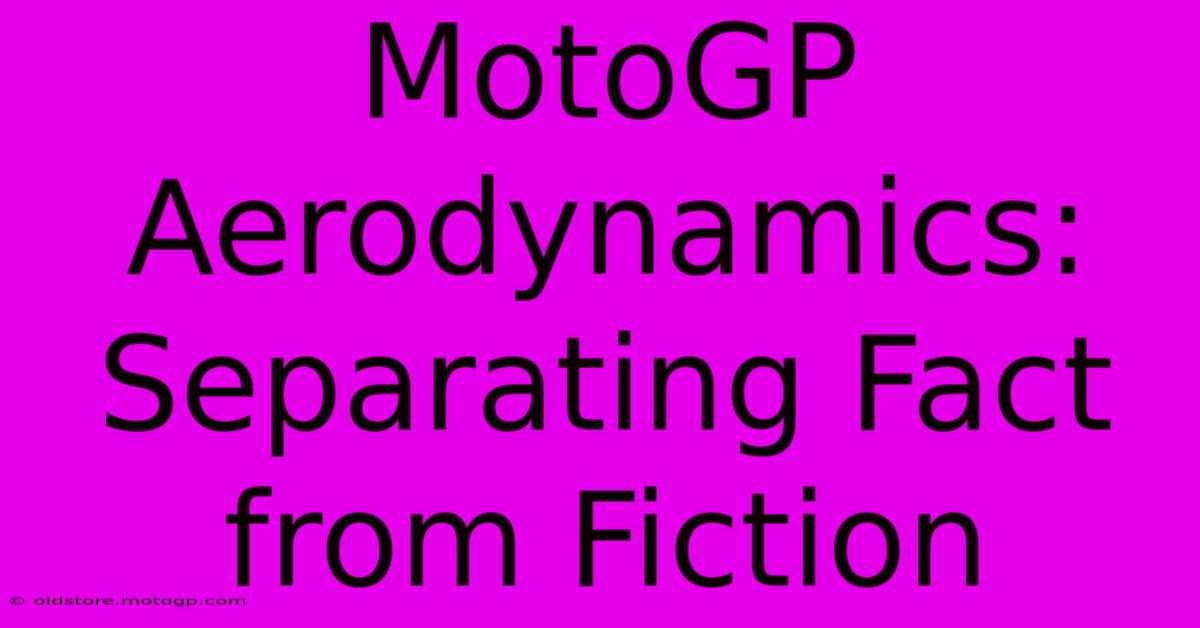MotoGP Aerodynamics: Separating Fact From Fiction

Table of Contents
MotoGP Aerodynamics: Separating Fact from Fiction
MotoGP racing is a relentless pursuit of speed, and aerodynamic performance plays a pivotal role in achieving that coveted edge. While the whirring engines and the breathtaking speeds capture the immediate attention, the subtle yet crucial science of aerodynamics is often overlooked. This article delves into the world of MotoGP aerodynamics, separating the facts from the prevalent myths and misconceptions.
Understanding the Aerodynamic Principles in MotoGP
MotoGP bikes, unlike their road-going counterparts, are meticulously designed to maximize aerodynamic efficiency at breakneck speeds. The primary goal is to reduce drag while simultaneously generating downforce.
Drag Reduction: The Pursuit of Speed
Drag is the resistance a body experiences as it moves through the air. In MotoGP, minimizing drag directly translates to higher top speeds and improved acceleration. Teams employ various strategies to achieve this:
- Streamlined Fairings: The sleek, sculpted fairings aren't just for aesthetics; they are meticulously designed using Computational Fluid Dynamics (CFD) to channel airflow smoothly around the bike, minimizing turbulence and drag.
- Aerodynamic Winglets: These small, wing-like appendages, strategically placed on the fairings, help to manage airflow and reduce drag in specific areas. Their design is crucial, as poorly placed winglets can actually increase drag.
- Rider Positioning: The rider's posture significantly impacts aerodynamic performance. A tucked position minimizes the frontal area exposed to the wind, reducing drag.
Downforce Generation: Cornering Mastery
Downforce is the force pushing the bike towards the track surface. This is crucial for high-speed cornering, allowing riders to maintain stability and lean angles without losing grip. Key elements contributing to downforce include:
- Aerodynamic Wings: Larger wings, often located on the front fairing and under the seat, generate significant downforce. These are carefully designed to balance downforce with drag, optimizing performance for specific circuits.
- Underbody Aerodynamics: The underbody of the bike also plays a crucial role. Teams carefully shape the undertray to manage airflow and create a ground effect, further enhancing downforce.
- Wheel Fairings: Even the wheel fairings are designed to minimize turbulence and contribute to overall aerodynamic performance.
Debunking MotoGP Aerodynamic Myths
Many myths and misconceptions surround MotoGP aerodynamics. Let's address some of the most common:
Myth 1: More Downforce is Always Better
Fact: While downforce is essential for cornering, excessive downforce increases drag, hindering straight-line speed. Teams constantly seek the optimal balance between downforce and drag, tailoring their setups to specific tracks and conditions.
Myth 2: Aerodynamic Wings are Only for Show
Fact: Aerodynamic wings are integral to high-speed cornering stability and performance. Their precise design and placement are crucial for generating sufficient downforce without excessive drag.
Myth 3: All Aerodynamic Solutions are Created Equal
Fact: The effectiveness of aerodynamic solutions depends heavily on their design, placement, and interaction with other components. Sophisticated CFD simulations and wind tunnel testing are crucial for optimizing performance.
The Future of MotoGP Aerodynamics
The pursuit of aerodynamic perfection in MotoGP is ongoing. Continuous advancements in materials, design techniques, and computational tools promise even more refined and sophisticated aerodynamic solutions in the years to come. We can anticipate further innovations, focusing on active aerodynamic systems that adapt to changing conditions for even greater performance.
The complex interplay of drag reduction and downforce generation in MotoGP showcases the intricate science behind this thrilling sport. By understanding the facts and debunking the myths, we gain a deeper appreciation for the technological prowess that drives these incredible machines and the riders who master them.

Thank you for visiting our website wich cover about MotoGP Aerodynamics: Separating Fact From Fiction. We hope the information provided has been useful to you. Feel free to contact us if you have any questions or need further assistance. See you next time and dont miss to bookmark.
Featured Posts
-
Moto Gp Live Online Free Stream Every Grand Prix
Feb 18, 2025
-
Cota F1 General Admission Vs Grandstands
Feb 18, 2025
-
The Best Way To Experience Cota General Admission
Feb 18, 2025
-
Cota Travel Your Guide To A Seamless Experience
Feb 18, 2025
-
Cota Parking Lot T Limited Spots Available Reserve Now
Feb 18, 2025
